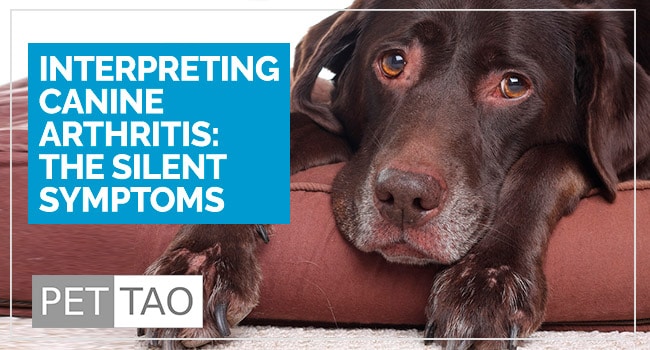Or maybe your older dog is showing signs of lethargy and joint discomfort?
The cause could be arthritis.
Even more fascinating is the fact that small dogs can have different signs and symptoms than large dogs.
These symptoms can wax and wane depending on various factors, including ambient temperature, previous exercise, and body condition.
Dogs are skilled at hiding symptoms of arthritis, especially in the early stages of the disease.
Here Are Three Most Common Dog Arthritis Symptoms
Limping
is the most common, consistent clinical sign of arthritis. Limping can originate from the front or back leg and can often be simultaneously in the front and back legs.
Arthritis is most common in the elbow in the front leg. The canine elbow is a unique joint consisting of the intersection of three bones: the radius, the ulna, and the humerus. The radius is considered the predominant weight-bearing bone and essentially supports the humerus.
The ulna locks into the humerus and allows elbow flexion and extension. The humerus is the bone that connects the shoulder to the elbow. Arthritis of the elbow can be debilitating and challenging to manage.
Arthritis commonly occurs in the back leg in two different joints: the stifle and the hip. The stifle, also known as the knee, is created by the junction of the femur and the tibia. The stifle is prone to arthritis primarily because of the many ligaments and tendons that course the joint.
Failure or partial tearing of these soft tissue structures predisposes this joint to arthritis.
The hip is a ball-and-socket joint between the femur and the pelvis. Its structure allows for 360-degree rotation. Repeated rotation over a lifetime, poor muscle development, and genetic malformations of this joint predispose the hip to arthritis.
Stiffness
Stiffness is the second most common symptom of arthritis. In my opinion, stiffness is most common in large-breed dogs. Stiff dogs do not want to flex and extend their joints because this movement causes pain. They tend to walk like a tin soldier. When a dog appears to walk stiffly, the affected joints are typically either the elbow and/or the stifle.
The Inability to Rise or Being Unwilling to Rise
Not getting up is the third most common clinical sign of dog arthritis. How often do you see a geriatric dog not get up when the owner calls? Or, how often do you see an older dog slip and slide all over the place when trying to rise?
This behavior occurs because of the pain caused by trying to flex and extend the joints to get up from sitting to standing.
Dogs try and try but can’t muster the strength nor tolerate the pain to perform this once-simple movement. The inability to rise occurs more frequently in geriatric dogs with multiple arthritic joints. The back, specifically the lumbosacral joint, is also often affected.
Other less frequent signs of dog arthritis include:
- Whining
- Behavior changes
- Aggressive behavior
- Inability or unwillingness to move
- Lethargy
Depending on the situation, your veterinarian may prescribe one medicine, multiple medicines, and/or some other type of treatment.
Remember, arthritis symptoms are not curable, but they are manageable.
More Powerful Tools for Overcoming Dog Arthritis Challenges
You can make many quick and easy changes at home to help you give your dog an edge on easing dog arthritis pain.
- Learn more about dog arthritis.
- Try cooking for your dog or feeding high-quality dog food. Home-cooked diets and wet food help keep your pet from gaining too much weight. Less weight means less stress on your dog’s bones and joints. PET | TAO Chill is one of our top choices for arthritic dogs.
- Ease your dog’s discomfort naturally. PET | TAO Comfort is a blend of Eastern herbs and Western supplements that soothe your dog’s arthritic challenges and make him/her more comfortable.
- Provide joint support. PET | TAO Harmonize Joint is a blend of Eastern herbs and Western supplements that lubricate and restore your dog’s joints.
- Try Freeze-Dried Kidney Treats. According to TCVM, the Kidney controls the bones and joints and supports arthritic challenges in a “like treats like” manner.
- Learn more about TCVM Herbal Remedies. Chinese medicine offers many exceptional natural solutions for dog arthritis. Some good examples are:








